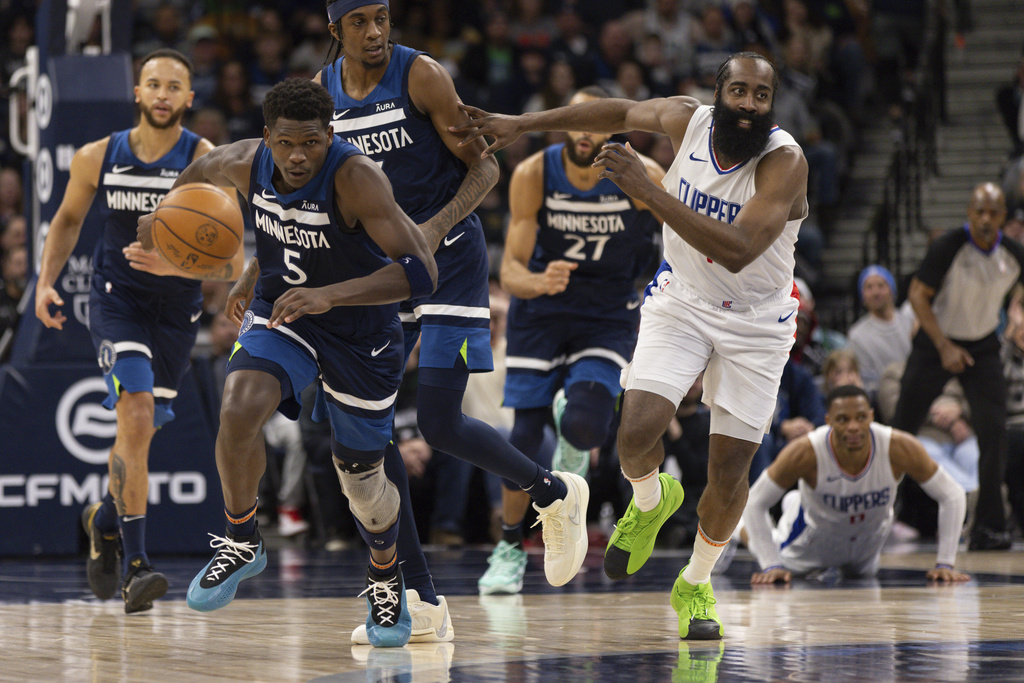
The key to unlocking the Timberwolves’ offense? Pace is king
Turnovers have plagued Minnesota’s offensive efforts all season. The Timberwolves tout the third-highest turnover percentage in the NBA (15.5 percent) – one of the few bugaboos in an otherwise highly successful season.
Minnesota Timberwolves guard Mike Conley passes away from New Orleans Pelicans center Jonas Valanciunas (17) in the second half of an NBA basketball game in New Orleans, Monday, Dec. 11, 2023. The Pelicans won 121-107. (AP Photo/Gerald Herbert)
Turnovers are one of the primary reasons why a team featuring such talent on the offensive side of the ball is middle of the pack in offensive efficiency. But they aren’t the only reason for that, nor is limiting them the only solution for improvement.
Timberwolves coach Chris Finch said Minnesota is working on improving its spacing, particularly around the different defensive looks opponents are throwing at Anthony Edwards in an attempt to trip the 22-year-old star guard up.
And then Finch mentioned a much simpler solution: Transition.
“We’re still trying to get better in transition,” Finch said. “I feel like there’s a lot to be gained there, still.”
Minnesota is highly effective in transition. It sports the third-best transition efficiency in the league, averaging 1.35 points per possession, per Cleaning The Glass. The problem is Minnesota rarely gets out in transition. The Wolves are 24th in transition frequency.
Now, Minnesota will never be a team that gets up and down at a high clip – the big, lengthy Wolves won’t thrive in a track meet. The Wolves are 23rd in pace, which has proven to be a winning formula for them. Because it’s difficult to score against Minnesota in a slowed down, half-court game.
But Finch’s insinuation is Minnesota could be more opportunistic in the transition department.
Because the half-court offense can be a bit of a slog for any team, particularly Minnesota, who faces a number of different defensive looks from opponents.
Even if Minnesota isn’t logging fast-break points – just 11.4 percent of the Wolves’ points come via the fast break, 23rd most in the Association – Minnesota can be quicker in its attack to generate better opportunities that would still be defined as half court.
In the regular flow of the game, Finch said he’d like the Wolves to be into their offense within the first four or five seconds of the shot clock.
“We’re usually six to eight seconds,” he said.
Those two or three additional seconds sacrifice how much you can achieve in a possession.
“It’s usually one more play and then a pass, at least,” Finch said. “With a couple seconds, you can make a play and a pass.”
But what Finch and Wolves guard Mike Conley would most like to see more of is Minnesota attacking before it even has to break into a set offense.
“I’ve always been in the boat that in the first four or five seconds you want to just try to score, drive in and try to make a play,” Conley said. “First seven seconds or so just be free, drive and kick, try to find something and try to find a defensive breakdown early.”
It’s a form of delayed transition.
“You definitely want to get kind of a sneak peek of what you can get away with early because sometimes you might not even have to do anything. The defense, somebody might fall down, somebody might have their head turned, just get back and run it at ‘em and try to get a bucket,” Conley said. “At that point once they’re set, it’s like, ‘All right, let’s see how the court is spaced,’ who has the matchup with who because we ran it at ‘em a little bit so there might be a mismatch there on the court. So that might dictate what play we’re going to run or who we’re going to go at. So I think just a little more pacing kind of helps all that.”
Whether it’s running the floor or the tempo with which the Wolves operate – pace is king, and perhaps the key to truly unlocking their offense — a likely area of focus as they head into a softer portion of the schedule. The Pistons on Wednesday mark the first of a string of opponents against which Minnesota should be able to dictate the terms under which the game is played.
Related Articles
Jace Frederick: The Timberwolves’ race for the No. 1 seed is officially on, and it matters
Timberwolves cool off red-hot Clippers
Wolves’ Karl-Anthony Towns is showing more elevation of late
Conley’s Corner: The gameday routine
Timberwolves trounce Portland to open softer stretch of schedule
“We don’t put the defense on their heels enough early in transition, at the end of transition,” Finch said. “To me, it’s more about that. Because if we can get into the paint within the first seven or eight seconds, then we know something good is going to happen.”

